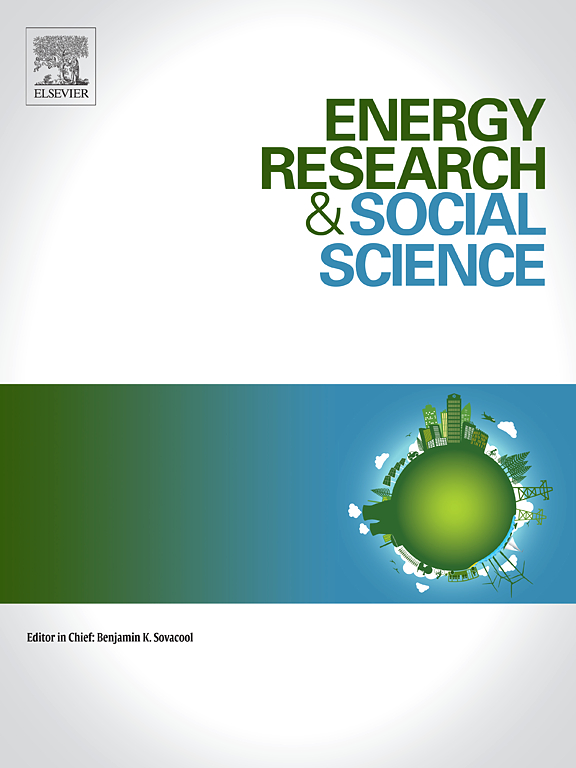超越开采的转型:印度两个煤矿区的空间与比较案例研究
IF 6.9
2区 经济学
Q1 ENVIRONMENTAL STUDIES
引用次数: 0
摘要
在气候变化的背景下,印度对煤炭的依赖面临越来越大的挑战,有必要在公正过渡原则的指导下逐步减少煤炭的使用。这项工作通过承认空间在推动公正的社会技术转型中的重要性,建立了对能源正义的空间分析的需求。根据对印度恰特拉区(贾坎德邦)和贾尔苏古达区(奥里萨邦)两个煤矿区进行的初步家庭调查,本工作利用当地的各种社会经济指标绘制了煤矿开采的地理足迹图。此外,对这两个采煤区进行了比较分析,考察了依赖煤炭的区域差异。研究结果表明,对煤炭的依赖主要与生计有关,主要集中在煤矿半径5公里范围内,超出这个范围就会大大减少。主要烹饪燃料对煤炭的依赖程度也较高,收入水平较高,企业社会责任活动也在此范围内。这项研究揭示了煤矿地区在煤矿关闭期间的脆弱性,突出了低技能水平、低土地持有模式和低社会保障计划(如配给卡)的覆盖率。结果表明,各采煤地区在生计依赖程度、烹饪燃料、技能培训、社会保障覆盖面等指标上存在显著的区域差异。这些见解强调了自下而上的方法来指导公正的能源转型的必要性,重点是根据当地情况调整战略。本文章由计算机程序翻译,如有差异,请以英文原文为准。
Just transition beyond extraction: A spatial and comparative case study of two coal mining areas in India
India's reliance on coal for development faces growing challenges amid climate change, necessitating coal phase-down, guided by the principles of just transition. This work builds towards the need for spatial analysis of energy justice by acknowledging the significance of space in driving a just socio-technical transition. Drawing on the primary household surveys in two coal mining regions of Chatra district (Jharkhand state) and Jharsuguda district (Odisha state) in India, this work maps the geographic footprint of coal mining using various socio-economic indicators in a local context. Further, a comparative analysis of these two coal mining regions has examined the regional variations in coal dependency. The findings indicate that coal dependency is predominantly tied to livelihoods and is concentrated primarily within a 5-kilometre radius of coal mines, diminishing substantially beyond this range. The coal dependency is also higher for primary cooking fuel, higher income levels, and corporate social responsibility activities in this range. This study exposes the vulnerability of the coal mining region during the closure of coal mines by highlighting the low skill levels, low landholding patterns and low coverage of social security schemes like ration cards. It is demonstrated that notable regional disparities exist among coal mining regions regarding reliance on coal for livelihoods, cooking fuel, skill training, social security coverage and other indicators. These insights underscore the necessity of a bottom-up approach to guide a just energy transition, with a focus on adapting strategies to local contexts.
求助全文
通过发布文献求助,成功后即可免费获取论文全文。
去求助
来源期刊

Energy Research & Social Science
ENVIRONMENTAL STUDIES-
CiteScore
14.00
自引率
16.40%
发文量
441
审稿时长
55 days
期刊介绍:
Energy Research & Social Science (ERSS) is a peer-reviewed international journal that publishes original research and review articles examining the relationship between energy systems and society. ERSS covers a range of topics revolving around the intersection of energy technologies, fuels, and resources on one side and social processes and influences - including communities of energy users, people affected by energy production, social institutions, customs, traditions, behaviors, and policies - on the other. Put another way, ERSS investigates the social system surrounding energy technology and hardware. ERSS is relevant for energy practitioners, researchers interested in the social aspects of energy production or use, and policymakers.
Energy Research & Social Science (ERSS) provides an interdisciplinary forum to discuss how social and technical issues related to energy production and consumption interact. Energy production, distribution, and consumption all have both technical and human components, and the latter involves the human causes and consequences of energy-related activities and processes as well as social structures that shape how people interact with energy systems. Energy analysis, therefore, needs to look beyond the dimensions of technology and economics to include these social and human elements.
 求助内容:
求助内容: 应助结果提醒方式:
应助结果提醒方式:


